All maple syrups are not created equal: A brief history of the sweet stuff we make from sap
| Published: 03-19-2024 1:26 PM |
March is Massachusetts Maple Month. Farmers in our area are working around the clock to turn the sap that flows from maple trees into the sweet elixir that New Englanders prize year round.
It’s not just full-time farmers who make maple syrup. My friend Marcia announced in church last week that she is thrilled to have collected a gallon of sap from her maple trees this year and is getting ready to boil it down into syrup.
Given the average ratio of 40 gallons of sap to one gallon of syrup, she will be lucky to end up with a half cup of syrup. Nevertheless, she will be proud to have participated in a longstanding New England cottage industry. And I’m sure she will treasure that half cup.
The first producers of maple syrup were Indigenous Americans, who boiled sap down to syrup long before Europeans arrived on these shores. No one is quite sure what alerted them to maple’s sweetness. It may have been an accident. Nevertheless, it was a popular flavoring agent for northern Native Americans. Colonists learned of maple’s sweet bounty from those who already lived here. In early colonial times, maple syrup and sugar were significantly less expensive than imported sugar from cane.
Eventually, many New England abolitionists embraced the syrup as a morally superior sweetener to sugar, which was produced by enslaved laborers. Thomas Jefferson wanted to produce maple syrup at his home farm in Virginia. Although he enslaved other human beings, he was allegedly opposed to slavery in principle. Moreover, he believed that maple production was a perfect activity for the yeoman farmer he saw as the American ideal.
The sugar maples Jefferson planted at Monticello died; the climate of southern states proved dicey for producing maple syrup. Sap needs cold weather to run. Nevertheless, I like to think of my neighbors who boil down syrup every year as Jeffersonian yeoman farmers.
As sugar became less and less expensive over the decades, even hardy New Englanders (unless they were strict abolitionists) changed over to cane sugar as their primary sweetener. Maple was increasingly viewed as it is today: as an expensive and highly prized specialty food.
We are lucky to live in an area where we can purchase pure maple syrup from neighbors and visit working sugarhouses.
Article continues after...
Yesterday's Most Read Articles
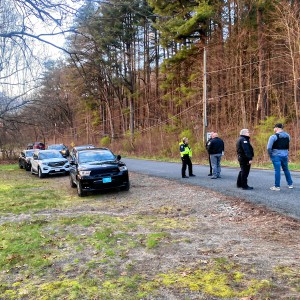 Police report details grisly crime scene in Greenfield
Police report details grisly crime scene in Greenfield
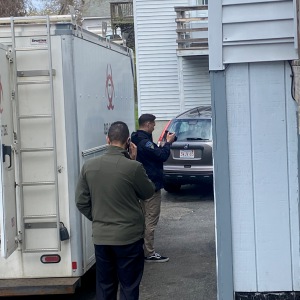 Authorities ID victim in Greenfield slaying
Authorities ID victim in Greenfield slaying
 State records show Northfield EMS chief’s paramedic license suspended over failure to transport infant
State records show Northfield EMS chief’s paramedic license suspended over failure to transport infant
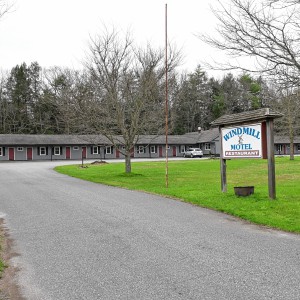 New buyer of Bernardston’s Windmill Motel looks to resell it, attorney says
New buyer of Bernardston’s Windmill Motel looks to resell it, attorney says
 On The Ridge with Joe Judd: What time should you turkey hunt?
On The Ridge with Joe Judd: What time should you turkey hunt?
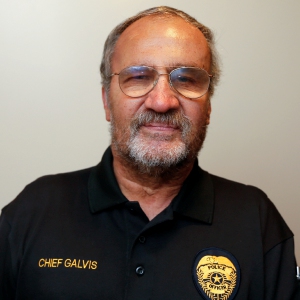 Ethics Commission raps former Leyden police chief, captain for conflict of interest violations
Ethics Commission raps former Leyden police chief, captain for conflict of interest violations
Despite this bounty, for years my mother refused to purchase Massachusetts Maple Syrup. Her family hailed from Vermont, and she had been indoctrinated at an early age in the belief that Vermont maple syrup had a superior taste to the product of other New England states.
When I was a child, her insistence on the difference in flavor between Vermont and Massachusetts syrup irritated me. It seemed absurd to drive north to purchase maple syrup when it was produced right here in western Massachusetts.
I have since learned many factors affect the phenotype — that is, the observable characteristics — of syrup. These include how it is collected and how it is processed. Kudos to my mother: the biggest difference in syrup taste, I now understand, is geographical.
I learned this lesson more than a decade ago when I visited a sugarhouse in the mountains of Virginia, where the altitude was higher than that of Jefferson’s home and the climate was consequently cooler.
The sugarhouse was owned and operated by an Amish family who were proud of their syrup and gave out samples. I tried it — and was gobsmacked. It was delicious, but it didn’t taste anything like the syrup I was accustomed to in New England.
When I thought this over, I was less surprised. Wines and fruits from different geographical areas take on different flavors based on climate and soil. This distinction in flavor is known as ”terroir” from the French “terre,” or land. Why shouldn’t maple flavor be determined by terroir as well?
When I got home, I apologized to my mother for my childhood crabbiness. She smiled a very superior smile. I’m sure readers who have mothers will know that smile.
Wherever I get my maple syrup — currently from my neighbors in Hawley, the Clarks, who tap my trees and always give me syrup at the end of the season as a thank you — my favorite uses for it are in savory dishes.
I seldom make salad dressing without a little maple in it. I love the contrast between the sugary syrup and the acidy vinegar.
Last week, I decided to try preparing a maple dish I remember eating and loving years ago at the now defunct Green Emporium in Colrain. There, chef Michael Collins used equal portions of soy sauce and maple syrup to produce a tasty salmon dish.
I’m not sure exactly what else Michael put in his salmon dish or how he cooked it. So I added flavors I knew would work: garlic and ginger. I baked my salmon, but I imagine one could broil it, too.
I was eating alone last week, but one could easily double this recipe. I ate it twice happily, enjoying its sweet and tart tango in my mouth. I even shared tiny nibbles with Cocoa the dog and Rhubarb the cat.
Ruby, who often turns her nose up at cat food, scarfed down her serving of salmon in no time and stared at me in a silent plea for more. I relented. Cats deserve a treat now and then.
Ingredients:
2 tablespoons maple syrup
2 tablespoons soy sauce
1 clove garlic, finely minced
a tiny finger of ginger (or a little more if you like), finely minced
ground pepper to taste
1/2 pound salmon filet
a few drops of sesame oil (optional)
Instructions:
Whisk the syrup, soy sauce, garlic, ginger, and pepper together with a fork or small whisk. Cut the salmon into 2 pieces. Put those pieces in a small baking dish, skin side up, and spoon the liquid over the fish.
Cover the dish, and let the fish marinate for 30 minutes, turning the salmon over halfway through and spooning some of the marinade over the top.
When you turn the salmon over, preheat the oven to 350 degrees.
When the salmon has finished marinating and the oven is hot, bake the salmon, uncovered, until it flakes when you stick a fork in, about 15 to 20 minutes.
If you can, spoon some of the marinade over the salmon at least once while baking.
Put the pieces of salmon on two plates and sprinkle a little sesame oil over all if you wish. Serves 2.
Tinky Weisblat is an award-winning cookbook author and singer known as the Diva of Deliciousness. Visit her website, TinkyCooks.com.

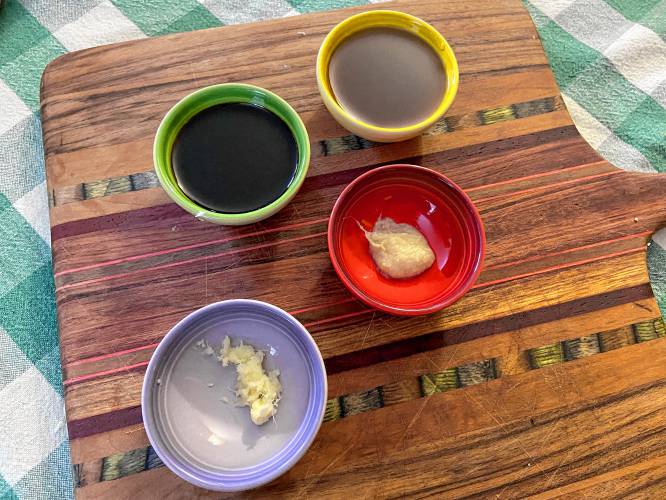
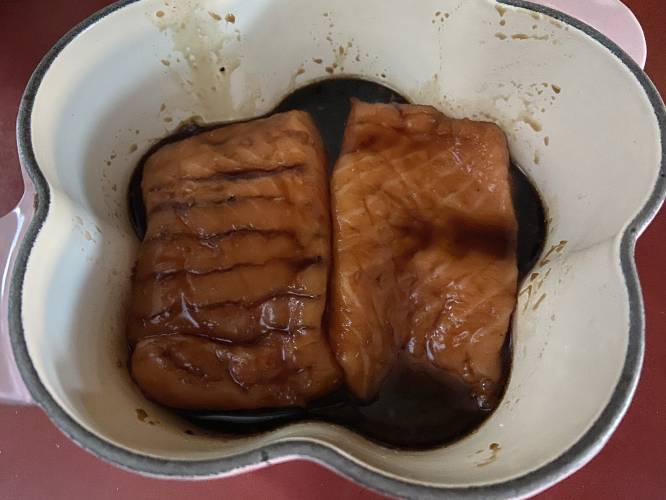
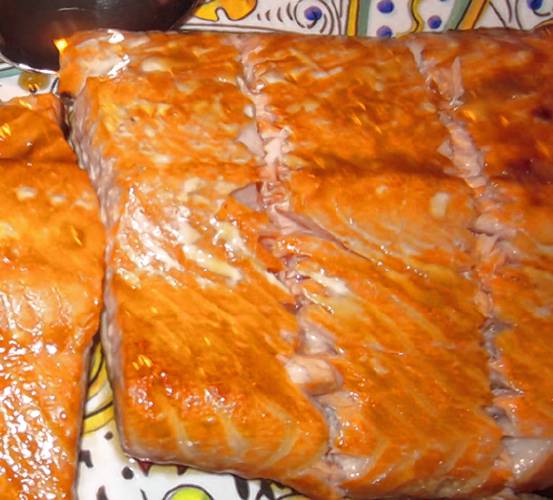
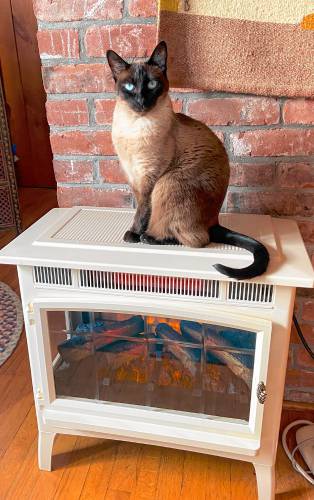
 Proof that it’s never too late: Solo exhibit and free workshops honor the late Frederick Gao, a Belchertown resident who became a painter in his last five years
Proof that it’s never too late: Solo exhibit and free workshops honor the late Frederick Gao, a Belchertown resident who became a painter in his last five years Self-expression on display: ServiceNet members’ artworks on view at Greenfield Public Library through end of May
Self-expression on display: ServiceNet members’ artworks on view at Greenfield Public Library through end of May Embracing both new and old: Da Camera Singers celebrates 50 years in the best way they know how
Embracing both new and old: Da Camera Singers celebrates 50 years in the best way they know how Time to celebrate kids and books: Mass Kids Lit Fest offers a wealth of programs in Valley during Children’s Book Week
Time to celebrate kids and books: Mass Kids Lit Fest offers a wealth of programs in Valley during Children’s Book Week
